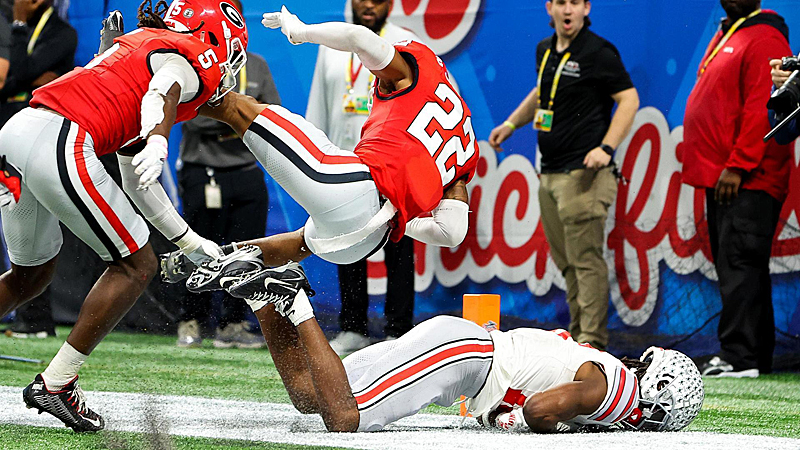
Strictly put, there’s very little question about whether the hit on Marvin Harrison was targeting…or whether it was missed, or interpreted properly. (Press Pros Feature Photo)
I don’t make New Year’s resolutions, but I am paying attention to those groups who tout change in culture, and in the way we go forward. Sports, especially, could use some shakeup. But the greatest thinking regarding change is to reward those who have already done the right things…for a long, long, time.
 If you watch the NFL games you can’t help but notice that some players have messages on the back of their helmets that say, ‘choose love’, or ‘inspire change’, while they go about giving each other life-altering concussions with violent collisions that are impossible to arbitrate.
If you watch the NFL games you can’t help but notice that some players have messages on the back of their helmets that say, ‘choose love’, or ‘inspire change’, while they go about giving each other life-altering concussions with violent collisions that are impossible to arbitrate.

“If they didn’t wear helmets it would be a safer game. They’d think twice about some of the hits they make.” – Lou Holtz
As an example, I don’t think there’s any doubt that the Georgia player who clocked Marvin Harrison, Jr. in the end zone Saturday night…was ‘targeting’ Harrison for the express purpose of putting Ohio State’s best threat out of the game. After review, they said there was no intent to target…which was a lie! So here’s my suggestion for change. Officiating in the NFL and college is increasingly poor because the players are simply too big and fast for the stripes to keep up with, physically or cognitively. So how to inspire change?
The game would be safer if players didn’t wear helmets, and I guarantee they’d think twice about some of the hits they make now without fear of repercussion. It would be a safer game (which we all say we want) – if they thought about being toothless for the rest of their life, or so disfigured they couldn’t breathe through their nose. Former coach Lou Holtz has said this for years, and while Lou is a funny guy…he claims he’s being serious.
By the way, rugby is rough, too. And there’s a reason they don’t wear helmets!
Until they do something this radical I don’t think there’s much that you can do to inspire change with football. And honestly, if there’s even one of you out there who can tell me that you enjoyed watching that hit…I want you to tell me personally. I don’t believe it.
Of course, when NFL players talk about change they’re talking about culture, specifically about how to redistribute the wealth and opportunity in America. Everything, they say, is on the table – generational reparation, affirmative action, and the constant reminder that those who foot the bill should not question or complain. Just pay your fair share…you’ll never miss it.
But for the sake of those who’ve always paid their fair share, there’s never been a limit on how long. Nor, is there any gesture of appreciation by the government for those who’ve always borne the brunt of paying America’s way. For the sake of inspiring change…perhaps there should be. Thus, the following suggestion.
If you’re 72 years of age and have a record of paying federal and state income tax for 50 years…you should no longer have to pay a dime, regardless of income. You’ve done your fair share. 50 years is a long time to underwrite the government. And I don’t think the person who coined the phrase about the only thing constant in life is death and paying taxes…meant it literally.
Consider this. If you’re 72 and have a record of paying property taxes for 45 years, you get a 50% discount for the remainder of your life.
This, by the way, would be a wonderful incentive for young people to work and pay taxes, knowing that there’ll come a day when you’re paid up. You’ve done your fair share!
It would also free up dollars for senior citizens by which they can afford to be more personally independent, especially those on fixed income…knowing that they no longer have to give away 25% of what they make once they reach a certain age. It would be especially helpful for those still paying on a mortgage.
Again, the reward here is for the elderly, who have long since done enough paying forward – that group of voters about whom the politicians say, “We haven’t done enough for the senior citizens.” I agree, and the person who wrote about death and taxes never meant that you need to write one more check before they lower you in the ground…you know, for old time’s sake!
I was talking this week with a friend in southern Ohio, who talked about how ticket prices have gone up for high school basketball. He mentioned paying $45 to take his wife and four kids to a recent game, for tickets and concessions.
We all know that prices have gone up. They’ve gone up for everything…because the costs have gone up. Profit margins have to be maintained because you cannot operate at a deficit and justify losing money on sports at the end of the year.
Athletic directors have some tough decisions to make, as well as some tough sells – how to staff events properly, including security, for which (sadly) there is an increasing need. And they point to the cost of officials, who increasingly ask for more money, because they deserve it. They’ve worked for almost nothing for decades. I feel for officials because there are fewer and fewer of them available – at least trusted, experienced ones. The days of Kyle Bachman, Dave Wortman, and Eric Brown working a Friday game together are past. Now officials have to drive greater distance, at greater cost, to get there. And frankly, I wouldn’t put up with the crowd abuse…not for $65.

It’s dollars and dimes…but forget the dimes.
But there is a concern, at $7, $8, or $10 (for a tournament game) if we won’t someday price high school sports out of the market – where only a select few in the community can, and will, afford to pay to watch a high school basketball game…and especially the ones where one team is dominant and wins 49-8. For years, the standard ticket price at the door was $5. Then it went to $6, and surprisingly, some people objected. Now, at $7, and higher, some are saying, “I won’t go.” Not everywhere, but in enough areas to have cause for concern.
Exacerbating the problem is the reality that in many areas it’s a case of supply and demand. Fewer kids are playing, some schools don’t have enough for JV teams, and the overall quality of play doesn’t justify a 50% increase in the price to see it, especially in the smaller schools. Remember now, this is the day where people have choices that they never before had on Friday and Saturday nights, and leaving high school basketball games to be viewed by parents, family, and friends. It’s not the community draw that it once was – not for $45.
Sadly, there is no obvious solution. It is what it is. Some point to cutting travel costs by only playing schools within twenty minutes or twenty miles. Others say that it’s unnecessary to have three officials. We used two for fifty years, until the third man was added twenty years ago, following the lead of the NCAA and the NBA. There would be some who say that going back to two would represent negative progress, and that’s not good, either.
But neither is the case for inspired change, and how to keep high school sports financially solvent. I don’t have the answer, and thanks to matters out of our control there’s no end in sight.
But if you think of something, write…or call your local athletic director. They’re dying to hear.



